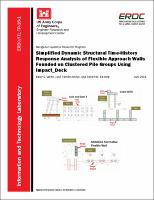Please use this identifier to cite or link to this item:
https://hdl.handle.net/11681/20336| Title: | Simplified dynamic structural time-history response analysis of flexible approach walls founded on clustered pile groups using Impact_Deck |
| Authors: | White, Barry C. Ebeling, Robert M., 1954- Arroyo, José Ramón |
| Keywords: | Structural analysis (Engineering)--Computer programs Locks (Hydraulic engineering)--Impact testing Barges--Impact testing Concrete beams Piling (Civil engineering) |
| Publisher: | United States. Army. Corps of Engineers. Engineer Research and Development Center (U.S.) Information Technology Laboratory (U.S.) Navigation Systems Research Program (U.S.) |
| Series/Report no.: | ERDC/ITL ; TR-16-1 |
| Abstract: | Abstract: Flexible approach walls are being considered for retrofits, replacements, or upgrades to Corps lock structures that have exceeded their economic lifetime. This report discusses a new engineering software tool to be used in the design or evaluation of flexible approach walls founded on clustered pile groups and subjected to barge train impact events. This software tool, Impact_Deck, is used to perform a dynamic, time-domain analysis of three different types of pile-founded flexible approach walls: an impact deck, an alternative flexible approach wall, and a guard wall. Dynamic loading is performed using Impact_Force time histories (Ebeling et al. 2010). This report covers the numerical methods used to create this tool, a discussion of the graphical user interface for the tool, and an analysis of results for the three wall systems. The results of analyzing the three wall systems reveals that dynamic evaluations should be performed for these structures because of inertial effects occurring in the wall superstructure and substructure. These inertial effects can cause overall and individual response forces that are greater than the peak force from the Impact_Force time history. This report also discusses the advantages of load sharing between multiple pile groups in an approach wall substructure. In the case of Lock and Dam 3, the peak reaction force for any individual pile group was 11% of the peak impact load. |
| Description: | At head of title: "Navigation Systems Research Program." |
| URI: | http://hdl.handle.net/11681/20336 |
| Appears in Collections: | Technical Report |
Files in This Item:
| File | Description | Size | Format | |
|---|---|---|---|---|
| ERDC-ITL TR-16-1.pdf | 31.53 MB | Adobe PDF |  View/Open |